GIGABYTE Server GA-7PESH3 Motherboard Review
by Ian Cutress on September 4, 2014 2:00 PM EST- Posted in
- Motherboards
- Intel
- Gigabyte
- Xeon
- Workstation
- Enterprise
- C602
CPU Benchmarks
Readers of our motherboard review section will have noted the trend in modern motherboards to implement a form of MultiCore Enhancement / Acceleration / Turbo (read our report here) on their motherboards. This does several things, including better benchmark results at stock settings (not entirely needed if overclocking is an end-user goal) at the expense of heat and temperature. It also gives in essence an automatic overclock which may be against what the user wants. Our testing methodology is ‘out-of-the-box’, with the latest public BIOS installed and XMP enabled, and thus subject to the whims of this feature. It is ultimately up to the motherboard manufacturer to take this risk – and manufacturers taking risks in the setup is something they do on every product (think C-state settings, USB priority, DPC Latency / monitoring priority, memory subtimings at JEDEC). Processor speed change is part of that risk, and ultimately if no overclocking is planned, some motherboards will affect how fast that shiny new processor goes and can be an important factor in the system build.
Point Calculations – 3D Movement Algorithm Test: link
3DPM is a self-penned benchmark, taking basic 3D movement algorithms used in Brownian Motion simulations and testing them for speed. High floating point performance, MHz and IPC wins in the single thread version, whereas the multithread version has to handle the threads and loves more cores.
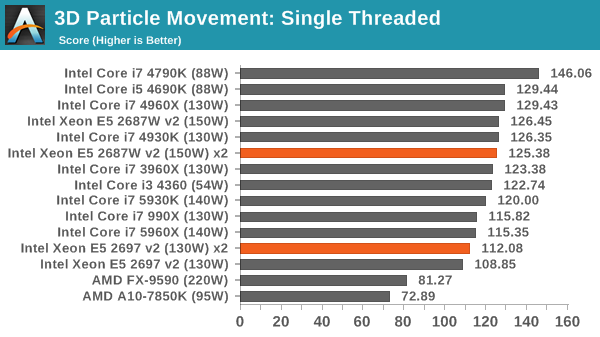
The single threaded test should be limited by the linear code, and we see in both dual CPU configurations it performs similarly to the single CPU result.
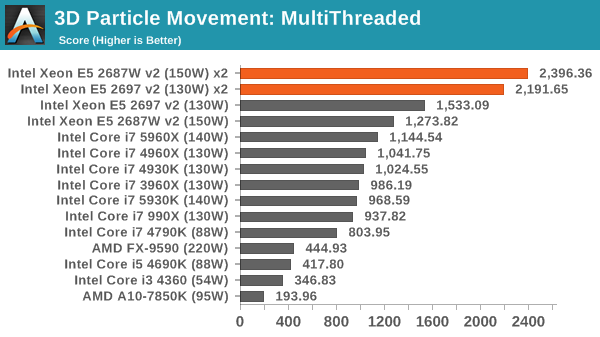
As the 3DPM algorithm involves no core-to-core data transfer, the 2P system can show its legs. Here the faster eight-core beats the slower 12-core.
Compression – WinRAR 5.0.1: link
Our WinRAR test from 2013 is updated to the latest version of WinRAR at the start of 2014. We compress a set of 2867 files across 320 folders totaling 1.52 GB in size – 95% of these files are small typical website files, and the rest (90% of the size) are small 30 second 720p videos.

WinRAR can take advantage of many threads in a system, however a 2P system presents some difficulty in managing that data. WinRAR also likes fast memory, and so as a result the single eight core 5960X can get a better result than any of our 2P configurations.
Image Manipulation – FastStone Image Viewer 4.9: link
Similarly to WinRAR, the FastStone test is updated for 2014 to the latest version. FastStone is the program I use to perform quick or bulk actions on images, such as resizing, adjusting for color and cropping. In our test we take a series of 170 images in various sizes and formats and convert them all into 640x480 .gif files, maintaining the aspect ratio. FastStone does not use multithreading for this test, and thus single threaded performance is often the winner.
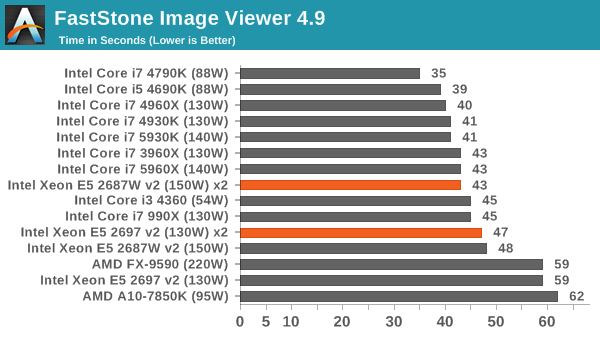
Video Conversion – Handbrake v0.9.9: link
Handbrake is a media conversion tool that was initially designed to help DVD ISOs and Video CDs into more common video formats. The principle today is still the same, primarily as an output for H.264 + AAC/MP3 audio within an MKV container. In our test we use two videos: a 640x266 2h20 film rip and a double UHD 10 minute animation short. Results are given in frames per second.
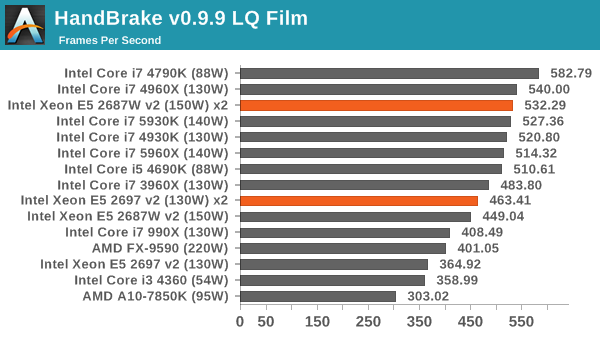
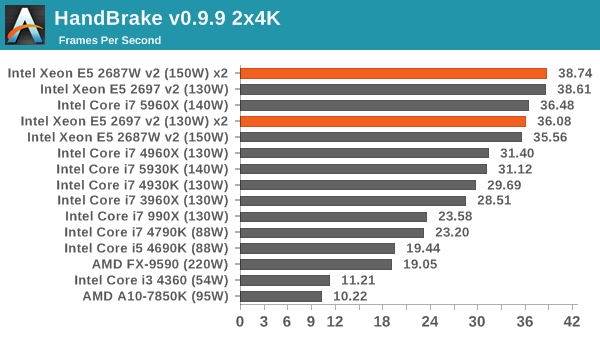
One would imagine that Handbrake could take advantage of all the extra cores on hand. For the LQ film, this is true at least for the faster frequency E5-2687W v2 model, however in 4K transcoding the data transfer between the CPUs becomes a bottleneck over raw CPU performance.
Rendering – PovRay 3.7: link
The Persistence of Vision RayTracer, or PovRay, is a freeware package for as the name suggests, ray tracing. It is a pure renderer, rather than modeling software, but the latest beta version contains a handy benchmark for stressing all processing threads on a platform. We have been using this test in motherboard reviews to test memory stability at various CPU speeds to good effect – if it passes the test, the IMC in the CPU is stable for a given CPU speed. As a CPU test, it runs for approximately 2-3 minutes on high end platforms.
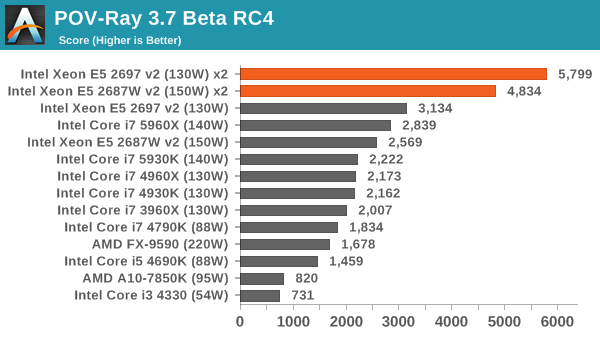
POV-Ray indicates more of what a 2P system should show: raw power. Here cores win out over frequency.
Synthetic – 7-Zip 9.2: link
As an open source compression tool, 7-Zip is a popular tool for making sets of files easier to handle and transfer. The software offers up its own benchmark, to which we report the result.
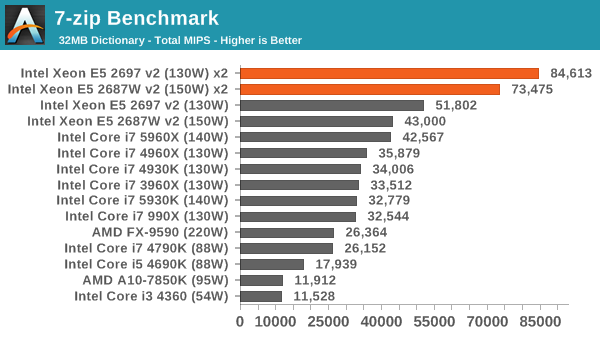










35 Comments
View All Comments
ShieTar - Friday, September 5, 2014 - link
Well, there is a tiny group of people who will be interested: They need a Workstation because they independently work with their PC to create content, but if possible they would also like to use the existing setup to game occasionally, instead of spend another 1k$ and put another Case next to their desk.Also, 10 years ago a lot of Trolls were posting "Yeah but can it run Quake" in the comment section of server hardware reviews. This kind of testing shuts them up.
xxsk8er101xx - Saturday, September 6, 2014 - link
Because the motherboard is designed for the prosumer market. Not the professional/server market. The point of the article is to basically say that this motherboard servers no purpose. It can't be used for the professional/server market because there are too few RAM slots and no mini-sas slots which the majority of the professional market has a need for.Kevin G - Sunday, September 7, 2014 - link
I think this motherboard has priced itself out of the prosumer market a bit at $650 USD and then you have Xeon prices on top of that. I do see this system being a decent pick for some professional tasks though. RAM capacity is still pretty decent as this board accepts 32 GB DIMMs for 256 GB capacity. That's a bit expensive due to 32 GB DIMM pricing but I see 128 GB via 16 GB DIMMs as reasonably priced for what you get. Needing more than 128 GB is a very small niche and one that overlaps widely with the idea of just using servers to batch process the large data sets anyway.The PCIe setup does scream professional though. Components like capture cards and PCIe SSDs are not going to be restricted in performance. (Though it is worrisome that this board doesn't have a dedicated aux power for just the PCIe slots.) The presence of onboard audio also indicates that this certainly isn't a server board.
I have yet to encounter a good reason for SAS in the professional space. 6 Gbit SATA provides enough bandwidth and SSD's can saturate that. SATA hard drives are adequate for bulk storage locally. (There is definitely a niche for SAS in server space with multi path IO for redundancy.) I can see a need for RAID5/6 in the prosumer and professional space but SAS isn't a requirement for it (though incidentally most RAID5/6 cards are SAS based). Even then, in most cases software RAID1 is 'good enough' for redundancy to prevent downtime in the professional space.
AnnihilatorX - Sunday, September 7, 2014 - link
Kindly read the article!: "While gaming is not a focus of motherboards like the GIGABYTE GA-7PESH3, the system may be in use by content developers relying on an accurate representation with what they are making. "gchernis - Thursday, September 4, 2014 - link
Nice write-up! Do you have any data on total CPU utilization with multithreaded tasks? What about kernel-time vs. user mode time split?JellyRoll - Thursday, September 4, 2014 - link
"Server motherboards historically have done rather poor in this test,"....perhaps because it is a server motherboard? are you testing a server workload on it?Samus - Thursday, September 4, 2014 - link
Anand used to do SQL benchmarks. This is what we need for this review to be complete.mavere - Thursday, September 4, 2014 - link
The Handbrake results are a bit disappointing because data-dependency breakpoints occur both naturally (at scene boundaries) and manually (at regular ~10s key-frame intervals). Conceptually, the transcoder can easily reuse the source's chapter-timing metadata and keyframes to outsource chunks of work to each socket with minimal communication overhead.I'm guessing that NUMA performance was never a pressing concern for any of Handbrake's and x264's contributors.
JDG1980 - Thursday, September 4, 2014 - link
I just can't see a good reason to buy into Ivy Bridge at this time, when Haswell-EP is just around the corner. Personally, I'm seriously considering the E5-1650 v3, assuming it comes in at a similar price point to its predecessor (and assuming that there are some decent workstation boards with ECC support available).And it's especially hard for AnandTech to justify the time reviewing this soon-to-be-obsolescent board when they still haven't gotten around to Tonga. I know it's not the most groundbreaking new GPU design (and AMD picked about the worst place in their lineup they possibly could to slot it), but still, it's a new GPU and we haven't seen a review despite every other major site doing so 2 days ago. What's going on with this?
ruthan - Thursday, September 4, 2014 - link
I would buy such machine for gaming if there would be performance benefit, so its good to know and mainstream everytime rules.. Its like SPARC or Power architecture, they cant compete because of mainstream x86 market is huge so, research revenue there are also huge, users requirements are bigger, more universal. This Sparc, Ithanium or Power market exist only because of stupid company policies, like everything from one company, support only for this HW, lies about super duper optimalisation for such HW, and especially license per CPU socket (here realy doesnt matter about price of CPU because, SW licence per socket is astronomical, so you are forced to buy Sparc or Power machine..).